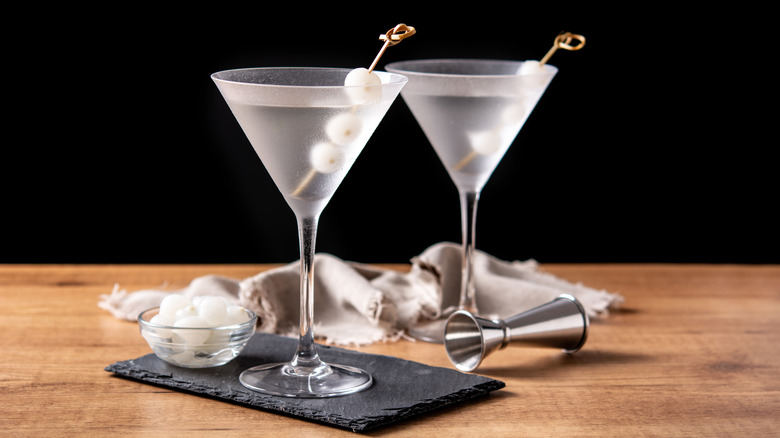The Difference Between A Gibson And A Martini Is All In The Garnish
When it comes to bartending knowledge, a few classic cocktails are essential to know. The Manhattan, old fashioned, Negroni, and sidecar are all fairly standard orders. And, of course, there's the martini. But while looking over recipes, you may notice that one other drink bears a striking resemblance: the Gibson.
At first glance, the Gibson may seem nearly identical to the standard martini. Both are served in martini glasses and made from a base of gin and vermouth. The Gibson is a variation of the martini, though its garnish makes it distinct.
While a martini will typically have an olive or lemon twist adorning the top of the glass, the Gibson goes for something a little more unusual: a cocktail onion. These onions are a little sweeter than the variety you'll find in salads or on top of burgers, and they're small enough that they don't overwhelm the cocktail.
You can craft your own cocktail onions
Making cocktail onions at home is easy if you have a little bit of time on your hands. Of course, since these are a cocktail garnish, you'll want the smallest onions you can find. Pearl onions are generally the best choice; the smaller, the better. Peel the onions, then cook them in a brine with pickling spice. Once the brine boils, remove the mixture from the stove, and pour it into a mason jar. Seal the jar and allow the onions to rest for two days before use.
Once your cocktail onions are ready, they can be added to your martini glass. Just be sure to slide the toothpick through either one or three of the onions — adding an even number of garnishes can bring bad luck, according to mysterious superstition, and is even considered a sign of poor hospitality by some. Though this tradition generally pertains to martini olives, it's better to play it safe and stick to the odd numbers.
No one is completely sure of the drink's origin
If you want to amplify the onion flavor, some recipes suggest adding a splash of pickling liquid from the onion jar to your cocktail. Though this addition deviates from the original recipe, the drink may have already seen some changes throughout the years. The first known recipe, published in 1908, called only for gin and vermouth — leaving out the bitters commonly added to martinis at the time and omitting the onion garnish.
As with many popular cocktails, the Gibson's origins are heavily debated and a little muddled. One theory suggests that the drink was named for businessman Walter D. K. Gibson at San Francisco's Bohemian Club. Another suggests the cocktail was created at the request of artist Charles Dana Gibson, who wanted an upgraded version of the standard martini, and the bartender added an onion.
Though the history of the drink may not be crystal clear, the Gibson is now as easily recognizable as its olive-garnished counterpart — though you can always tell the difference based on the pickled onion topping.


